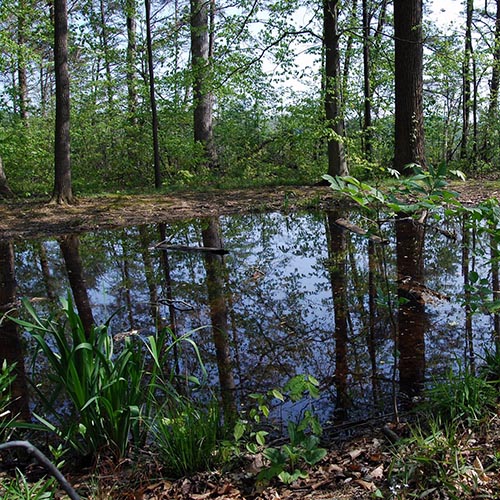
Listen to this Episode:
- From this webpage:
- Find the media player located under the episode picture.
- Click on the green triangle to listen to the audio for this episode.
- From your favorite podcast listening platform:
- Search for “Backyard Ecology.”
Show notes:
Vernal pools are a special type of shallow wetlands that fill with snow melt and rain in late fall through early spring, then dry up sometime during the summer. Because they dry up, they are sometimes overlooked or dismissed as “not very good wetlands.” However, they serve an important role in the ecosystem and can be teeming with all kinds of life.
In this episode, we talk with Tom Biebighauser about vernal pools. Tom is a wildlife biologist, wetland ecologist, educator, and author. He has written multiple books about vernal pools and has made a career of restoring and creating wetlands. Throughout our conversation, Tom shares many stories about creating vernal pools on his own property, on other people’s properties, and at schools.
Almost by definition, vernal pools don’t contain fish, because fish wouldn’t be able to survive when the vernal pool dries up. However, because they don’t have fish, vernal pools are extremely important breeding sites for frogs, toads, salamanders, and many aquatic invertebrates. In more permanent bodies of water, those animals and their eggs, tadpoles, and larva would face a significant threat of being eaten by hungry fish, but that’s obviously not a risk in a place where there aren’t any fish.
In many states, 90% of our wetlands have been drained and filled. This is especially true for vernal pools, probably because they do dry out for part of the year. Vernal pools are often relatively small – sometimes only the size of a living room or even smaller. They are also very shallow, usually only inches to maybe a foot or so deep, and have gently sloping sides.
One of the reasons that wetlands are often drained is for mosquito control. However, mosquitoes typically aren’t a problem around vernal pools because the mosquito eggs and larvae are eaten by everything that is in the vernal pool. If a vernal pool or wetland holds water for more than a couple of months then it will attract frogs, dragonflies, damselflies, and other mosquito predators.
Many people are probably familiar with the concept of rain gardens and may even have a rain garden already. However, vernal pools differ from rain gardens in that vernal pools hold water for several months, while rain gardens go dry much faster. Because rain gardens typically only hold water for a few hours to a few days, they don’t develop the complex ecosystems of a vernal pool.
There are lots of opportunities to create vernal pools around our homes, on our school grounds, or in other places within our communities. The cost of creating a vernal pool can range from practically nothing, to a few hundred dollars, to several thousand dollars, depending on the size of the vernal pool you want to create, the type of soil you have, and how much labor you want to do yourself. However, in many cases there are funds available to help cover the costs of creating vernal pools or other shallow wetlands. Tom has written several books that walk you through how to create vernal pools. His books plus lots of free resources and guides are available through his website.
Links:
- Tom’s website
- Tom’s books
- Tom’s email: tombiebighauser@gmail.com
- Other resources Tom recommends:
- Backyard Ecology’s website
- My email: shannon@backyardecology.net
* Amazon links are affiliate links and I earn a small commission from qualifying Amazon purchases made the link. The commission is paid by Amazon and comes at no extra cost to you, but helps support the costs associated with hosting the Backyard Ecology blog, podcast, and website.
Episode image:
- Vernal pool created at McBrayer Elementary school
- Photo credit: Thomas Biebighauser
Please tell your friends about Backyard Ecology.
(Social media sharing buttons can be found below the footer.)

Backyard Ecology: Exploring Nature in Your Backyard
Nature isn’t just “out there.” It’s all around us, including right outside our doors. Hi, my name is Shannon Trimboli, and I am the host of Backyard Ecology. I live in southcentral Kentucky and am a wildlife biologist, educator, author, beekeeper, and owner of a nursery specializing in plants for pollinators and wildlife conservation. I invite you to join me as we ignite our curiosity and natural wonder, explore our yards and communities, and improve our local pollinator and wildlife habitat. Learn more or subscribe to my email list at www.backyardecology.net.

Leave a Reply